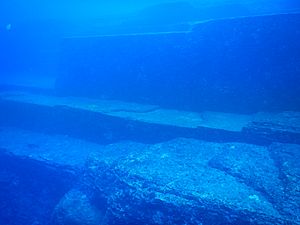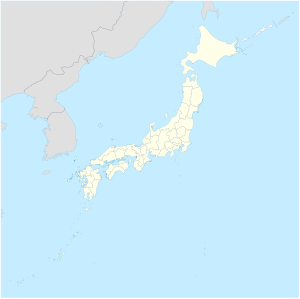Yonaguni Monument facts for kids
Quick facts for kids Yonaguni Monument |
|
|---|---|
| Yonaguni Submarine Topography | |

Yonaguni Monument, as seen from the south of the formation.
|
|
| Location | |
| Coordinates | 24°26′09″N 123°00′41″E / 24.435833°N 123.011389°E |
| Offshore water bodies | Philippine Sea |
| Depth | 26 m (85 ft) |
| Geology | Rock formation |
The Yonaguni Monument (Japanese: 与那国島海底地形, Hepburn: Yonaguni-jima Kaitei Chikei, lit. "Yonaguni Island Submarine Topography"), also known as "Yonaguni (Island) Submarine Ruins" (与那国(島)海底遺跡, Yonaguni(-jima) Kaitei Iseki), is a huge rock structure found underwater. It is located off the coast of Yonaguni Island in Japan. This island is the most southern of the Ryukyu Islands. The monument is about 100 kilometres (54 nmi; 62 mi) east of Taiwan.
Some people, like marine geologist Masaaki Kimura, believe these formations were made by humans. They think the monument is made of giant, carved stones called monoliths. However, other experts say these ideas are not based on real science. This is sometimes called pseudoarchaeology. The Japanese government and the government of Okinawa Prefecture do not see the Yonaguni Monument as an important cultural site. They have not done any research or work to protect it.
Contents
Discovering the Underwater Mystery
The waters around Yonaguni are a popular spot for divers. Many people visit in winter to see the large groups of hammerhead sharks. In 1986, a man named Kihachiro Aratake was looking for a good place to watch sharks. He was the director of the Yonaguni-Cho Tourism Association. That's when he saw some unusual rock shapes on the seabed. They looked like buildings or structures.
Soon after, a group of scientists came to study the formations. They were led by Masaaki Kimura, a professor from the University of the Ryūkyūs. Since then, the Yonaguni Monument has become a popular place for divers. Even with strong currents, many people want to explore it. Famous visitors include freediver Jacques Mayol, who wrote a book about his dives there.
Where It Is and What It's Made Of
The Yonaguni formations are found below the Arakawabana cliff. This cliff is at the southern tip of Yonaguni island. The main part of the monument faces south-southeast.
The monument is made of sandstone and mudstone. These are types of rock that formed about 20 million years ago. Most of the rocks in the monument are connected to the larger rock mass below. They are not just loose stones placed together.
Is It Natural or Man-Made?
Many scientists believe the Yonaguni Monument was formed by nature. Geologist Robert Schoch is one of them. He says the sandstone rocks there have many natural, parallel layers. These layers can easily break apart. The rocks also have many parallel cracks that go up and down. These cracks are natural and can create rectangular shapes. Yonaguni is in an area where earthquakes happen often. Earthquakes can cause rocks to break in regular patterns.
Schoch also points out that similar rock formations can be seen on the northeast coast of Yonaguni. John Anthony West visited the site with Schoch and agreed it was natural. He felt that Kimura had not looked closely enough at how natural processes work. Schoch believes the "drawings" some people see are just natural scratches on the rocks. He thinks the "walls" are simply natural flat rock layers that tilted when the rock below them wore away. The "roads" are likely just natural channels in the rock.
Another geologist, Wolf Wichmann from Germany, studied the formations in 1999 and 2001. He also concluded that they could have been formed by natural processes. On Yonaguni island, at a place called Sanninudai, there are step-like sandstone formations on land. These look similar to the underwater ones. Robert Schoch and Patrick D. Nunn, a professor who studies ocean geology, both agree that these formations are purely natural.
Ideas About Man-Made Structures
Masaaki Kimura first thought the Yonaguni Monument was at least 10,000 years old. At that time, the area would have been above water. He thought it might be a leftover from the mythical lost continent of Mu. Later, in 2007, he changed his idea. He said it might be 2,000 to 3,000 years old. He suggested that after it was built, movements in the Earth's crust caused it to sink underwater. However, archaeologist Richard J. Pearson thinks this is unlikely.
Kimura believes he can see a pyramid, castles, roads, monuments, and even a stadium in the formations. He also thinks these structures might be from the ancient Yamatai culture.
People who believe the monument was made by humans, like Graham Hancock, argue that it's unlikely so many unusual formations would be in such a small area if they were all natural. They also point out that there are not many loose rocks on the flat parts of the formation. If it was formed only by natural wearing away and breaking, they would expect to see more loose pieces. However, Robert M. Schoch notes that strong currents sweep through the area. These currents could easily move loose rocks away.
See also
 In Spanish: Estructuras de Yonaguni para niños
In Spanish: Estructuras de Yonaguni para niños
- Bimini Road
- Giant's Causeway
- Marine archaeology in the Gulf of Cambay
- Pantelleria Vecchia Bank Megalith
- Unidentified submerged object


